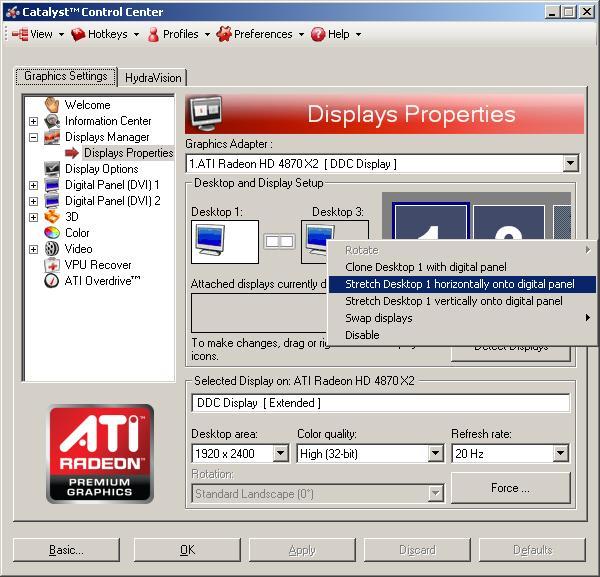When I set out to do this, I thought getting everything working under Windows would be easier than it was under Linux. After all, the drivers should be more mature and AMD would have likely put more effort into making sure things “just work” with their drivers. The experience has shown this expectation was unfounded. Getting the T221 working in SL-DVI 3840×2400@13Hz mode was trivial enough, but getting the 2xSL-DVI 2x1920x2400@20Hz mode working reliably has proven to be quite impossible.
The first problem has been the utter lack of intuitiveness in the Catalyst Control Center. It took a significant amount of research to finally find that the option for desktop stretching across two monitors lies behind a right click menu on an otherwise unmarked object:
Results, however, were intermittent. Sometimes the resolution for the second half of the screen would randomly get mis-set, sometimes it would work. Sometimes the desktop stretching would fail. Eventually, when it all worked (and it would usually require a lot of unplugging of the secondary port to get a usable screed back), it would be fine for that Windows session, but it would all go wrong again after a reboot. The screen would just go to sleep at the point where the login screen should come up, and the only way to wake it up is to unplug the secondary DVI link, log in, and then plug in the second cable, usually a few times, before it would come up in a usable mode. Then the same resolution and desktop stretching configuration process would have to be repeated – with a non-deterministic number of attempts required, using both the Windows display settings configuration and the Catalyst Control Center.
At first I thought it could be due to the fact that I am using an ATI HD4870X2 card, so I disabled one of the GPUs. That didn’t help. Then I tried using a different monitor driver, rather than the “Default Monitor” which is purely based on the EDID settings the monitor provides. I tried a ViewSonic VP2290b-3 driver (this was a rebranded T221), and a custom driver created using PowerStrip based on the EDID settings, and neither helped. Since I only use Windows for occasional gaming and not for any serious work, this isn’t a show stopping issue for me, but I am stunned that AMD‘s Linux drivers are more stable and usable than the Windows ones when using even slightly unusual configurations.
To add a final insult to injury, 4870X2 card doesn’t end up running the monitor with one GPU running each 1920×2400 section. Instead, one GPU ends up running both, and the 2nd GPU remains idle. At first I attributed the tearing between the two halves of the screen to be due to each half being rendered by a different GPU. Unfortunately, considering that all tests show that one GPU remains cold and idle while the other one is shown to be under heavy load, I have to conclude that this is not the case. This is particularly disappointing because the experience is both visually bad (tearing between the two 1920×2400 sections) and poorly performing (one GPU always remains idle and the frame rates suffer quite badly – 7-9fps in the Crysis Demo Benchmark). I clearly recall that my Nvidia 9800GX2 card I had before had a configuration option to enable dual-screen dual-GPU mode.
I am just about ready to give up on AMD GPUs, purely because the drivers are of such poor quality and lacking important features (e.g. requirement of fakexinerama under Linux, something that Nvidia drivers have a built in option for). I’m going to dig out my trusty old 8800GT card and see how that compares.

